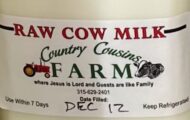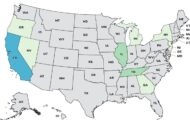The USDA is going to change its import regulations for bovine spongiform encephalopathy (BSE), more commonly known as mad cow disease, to bring it in line with international standards.
The World Health Organization for Animal Health (OIE) uses certain criteria when they classify a country’s BSE risk status. There are three categories of risk, ranging from smallest to highest: “negligible, controlled, and undetermined.”
This new proposal would require the Animal and Plant Health Inspection Service (APHIS), part of the USDA, to use the same criteria. This change will not have any effect on other measures in place to guard against the disease. There is a BSE surveillance program in place in this country which bans animal materials that carry the BSE prion.
The criteria used to place countries in the different categories include a ban on giving cattle food that is made from cattle parts, controlling imports of animal products from countries with “undetermined” risk, and conducting surveillance. At this time, the United States is classified as a “controlled risk” country, but the USDA would like to have “negligible risk” status.
The OIE Code rates risk based on the specific product. Boneless beef, for instance, has lower risk and can be imported in spite of a “undetermined” risk status of the country of origin. But a live cow has a higher chance of carrying the prion, so “negligible” risk rating is important when considering whether the animal should be allowed to enter the country.
The proposal would give the U.S. more power when negotiating beef exports. Until now, this country’s regulations have prompted some countries to ban U.S. beef. Japan and China, for instance, placed restrictions on U.S. beef nine years ago after a cow on a Washington state ranch was diagnosed with BSE.
There have been three diagnosed cases of BSE in United States cattle in the past nine years:
- In 2003, a cow in Washington State’s Yakima Valley was diagnosed with BSE. That cow had recently been imported from Canada. The cow was nonambulatory before slaughter and was examined by a FSIS veterinarian. The brain, spinal cord, and small intestine of that cow were tested after slaughter and found to be “high risk for the transmission of the BSE agent” after the meat from that cow was released into the food supply. A recall was initiated and the FSIS claimed they located “all known potentially infectious rendered products from the BSE-positive cow.”
- In 2005, a cow in Texas was diagnosed with BSE. That cow was born before the implementation of the 1997 feed ban that prohibited animal meat and bone meal in ruminant feed (basically cow cannibalism). The cow was dead on arrival at the packing plant and was shipped to a pet food plant. It was sampled for BSE there; the test was positive. The plant didn’t use the cow in its product.
- In 2006, a 10-year-old Alabama cow was diagnosed with BSE. That animal was also born before the feed ban. The animal died and was buried on the farm. The USDA excavated its remains and DNA tests were performed to make sure it was the same cow that tested positive for BSE.
There have been three cases of BSE, which is known in people as variant Creutzfeldt-Jacob Disease (vCJD) in human beings in the United States since 2001. vCJD cases are attributed to the country where the patient lived when symptoms began, no matter where he or she may have contracted the disease.
- The first patient was born in the UK and moved to Florida in 1992. Symptoms began in 2001; the patient died in 2004.
- The second patient started showing symptoms in 2005. He was born in the UK and lived there from 1980 to 1996. He lived in Texas from 2001 to 2005. THE CDC believes he acquired BSE in the UK.
- The third patient was born and raised in Saudi Arabia, but lived in the U.S. since 2005. Symptoms began in the spring of 2006. The CDC thinks he acquired the prions in Saudi Arabia, since there is a usually a 7-year incubation period for food-related BSE.
Dr. John Clifford, the chief veterinarian at the USDA, said “The rule does bring us in line with science regarding this particular disease. This rule will also assist us to reopen markets or open new markets, and bring us in line with OIE standards that we have asked other countries to comply with.”
The public comment period on this new rule will open within the next week. You can read the docket and find questions and answers at the USDA website.




